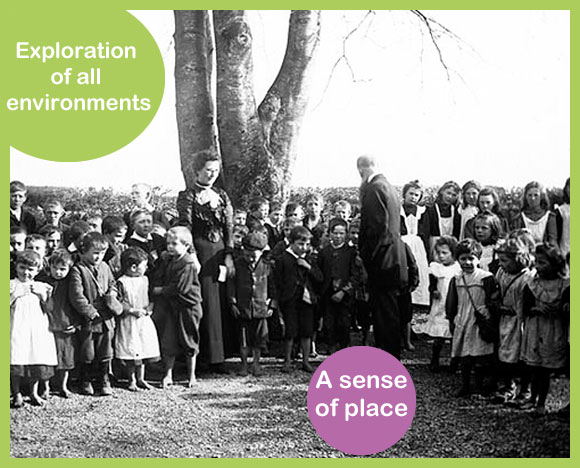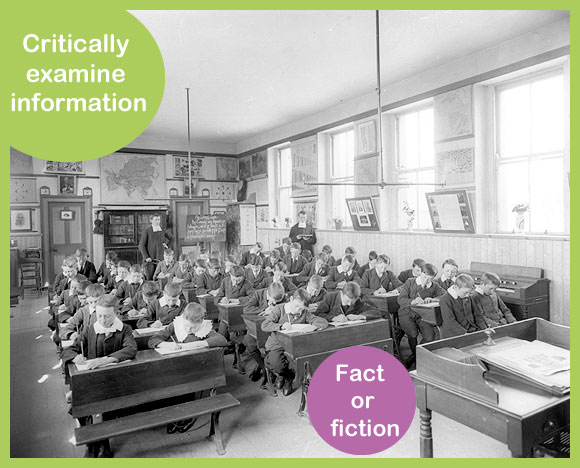Threads in the curriculum
Threads is an initiative that provides an online space for schools to store and share their student’s oral history projects. The project is primarily about encouraging students to become historians, and specifically, ‘oral historians’ to engage in the collection of stories and histories about their locality and to gather living people’s testimony about their own experiences and memories.
‘Locality’ is key to how Threads should work and as such it gives the project a wide appeal to encompass more than just the History curriculum – aspects of Geography too put a huge emphasis on ‘the local environment’ while seeking oral accounts about events or places can also make it specifically relevant to Religious Education, SPHE, CSPE (Post-Primary) and Transition Year.
Naturally, the emphasis on oral sources, written records and potential digital presentation of findings makes the Threads initiative extremely relevant to promoting a wide range of literacy skills too.
Primary
Enabling Active Exploration
The potential for using Threads in The Primary SESE curriculum is obvious. In the introduction to SESE the curriculum states:
A key characteristic to learning within SESE is the involvement of the child in the active exploration of all environments.In relation to History, the concept of ‘Working as an Historian’ underpins the content of the curriculum and it states:
"Engaging in the process of historical enquiry is an essential element of history. Thus, the curriculum provides for the development of a growing range of historical skills and concepts as children study the lives of people in the past.
Curriculum
. . . The exploration of the immediate environment will reveal many instances of which people in the past have shaped elements of our present surroundings through settlement, farming and other activities. But the influence of the past is not confined to the physical and material world. History can also reveal how our sense of identity – on a personal level and as a member of a family, national and other communities – has been shaped by the cultural and social experiences of many different peoples in the past."

The curriculum also puts an emphasis on how a historical education complements geographical and scientific learning:
"Many of the topics will arise out of the child’s need to explore and understand his/her immediate environment and local community."
Curriculum
Within SESE Geography the curriculum places a huge emphasis on developing a sense of place and space:
"The child’s sense of place refers to his/her understanding of, and feeling for, the essential character of different places: an understanding of how landscapes have been formed and shaped by the interaction of natural processes and human activity, and an appreciation of the distinctive contribution made by the motivations, beliefs, values and attitudes of people. A sense of place enables the child to recognise the unique identity of a place and to appreciate what it would be like to live there."
Curriculum
- Engaging with a Threads project would develop:
- The child’s oral skills of listening, questioning, discussing and arguing
- Social skills of interaction and co-operation
- An understanding of social change, tradition, conflict and cause
- Skills of empathy with individuals from a different generation
- Skills of sifting and selecting evidence
- Understanding the problems of bias and contradictory evidence.
Post Primary
Applicable across Junior, Transition and Senior cycle
Threads could be used across many subjects to develop the skills that we are trying to nurture in our education system. Without going into specifics for all subjects, the most obvious usage for Threads is seen in History, Geography and Religious Education. But other subjects too, like English and the new Politics and Society would offer potential for curriculum engagement with the project.
In Senior Cycle History a lot of attention is focused on the in-depth study of particular topics. But underpinning this is an emphasis on developing the skills of the historian, in particular the skills of working with evidence and researching. It is worth bearing in mind that a research study is a compulsory part of Leaving Certificate History, and could well fit into a Threads theme, while documents handling skills that might be developed through Threads would assist other parts of a Leaving Certificate History student’s work.At Junior Cycle level the study of the Job of the historian is a fundamental part of the curriculum as it introduces students to the historical methods and the exploration of sources.
Students in Transition Year could use Threads to build on the skills learnt at Junior Cycle level and to further develop their ability to critically examine information, distinguish between fact and fiction, and synthesise arguments and offer explanations.

In Geography, oral evidence can be used in conjunction with maps and documents to support the study of settlements, the local area and the impact of changes in the environment and work practices on ‘ordinary’ people. Indeed, the first line of the curriculum at Junior Cycle states:
"Geography is the study of people and their relationship with their environment.
Curriculum
. . . The syllabus is based on a belief that an adequate understanding of many of the issues with which geographers are concerned can be reached only with an appreciation of the human attitudes and values concerned."
In the study of Religious Education projects or oral interviews with people from the different faith communities provides many opportunities for students to develop an understanding of the customs, practices and stories associated with them. Pulling directly from the aims of RE in the syllabus:
"To identify how understandings of God, religious traditions, and in particular the Christian tradition, have contributed to the culture in which we live, and continue to have an impact on personal life-style, inter-personal relationships and relationships between individuals and their communities and contexts."
Curriculum
The above are just selected examples of how Threads could be used within the specifics of certain subjects within the curriculum. Usage of Threads would engage directly in fostering all the eight key skills of the Junior Cycle that have become so important:
- Managing Myself: Developing strategies to make considered decisions, to take action and to reflect on their progress.
- Staying Well: Supporting them in the safe and ethical use of digital technology.
- Communicating: Developing learners’ confidence in communicating, expressing opinions, writing, making oral presentations and performing.
- Being Creative: Developing imagination and creativity as they explore different ways of doing things and thinking.
- Working with Others: Appreciating the value of cooperating to reach both collective and personal goals.
- Managing Information & Thinking: Improving capacity to search for information from different sources. Developing skills of judgment and discriminating between information types and sources.
- Being Literate: Expressing ideas clearly and accurately. Developing an understanding and enjoyment of words and language.
- Being Numerate: Seeing patterns, trends and relationships. Gathering, interpreting and representing data.
In addition, Threads directly supports a number of the Statements of Learning:
Thus we can see that, even as Junior Cycle specifications in History and Geography are not yet finalised, there is huge scope for Threads to support student engagement and learning in these and other subjects.

